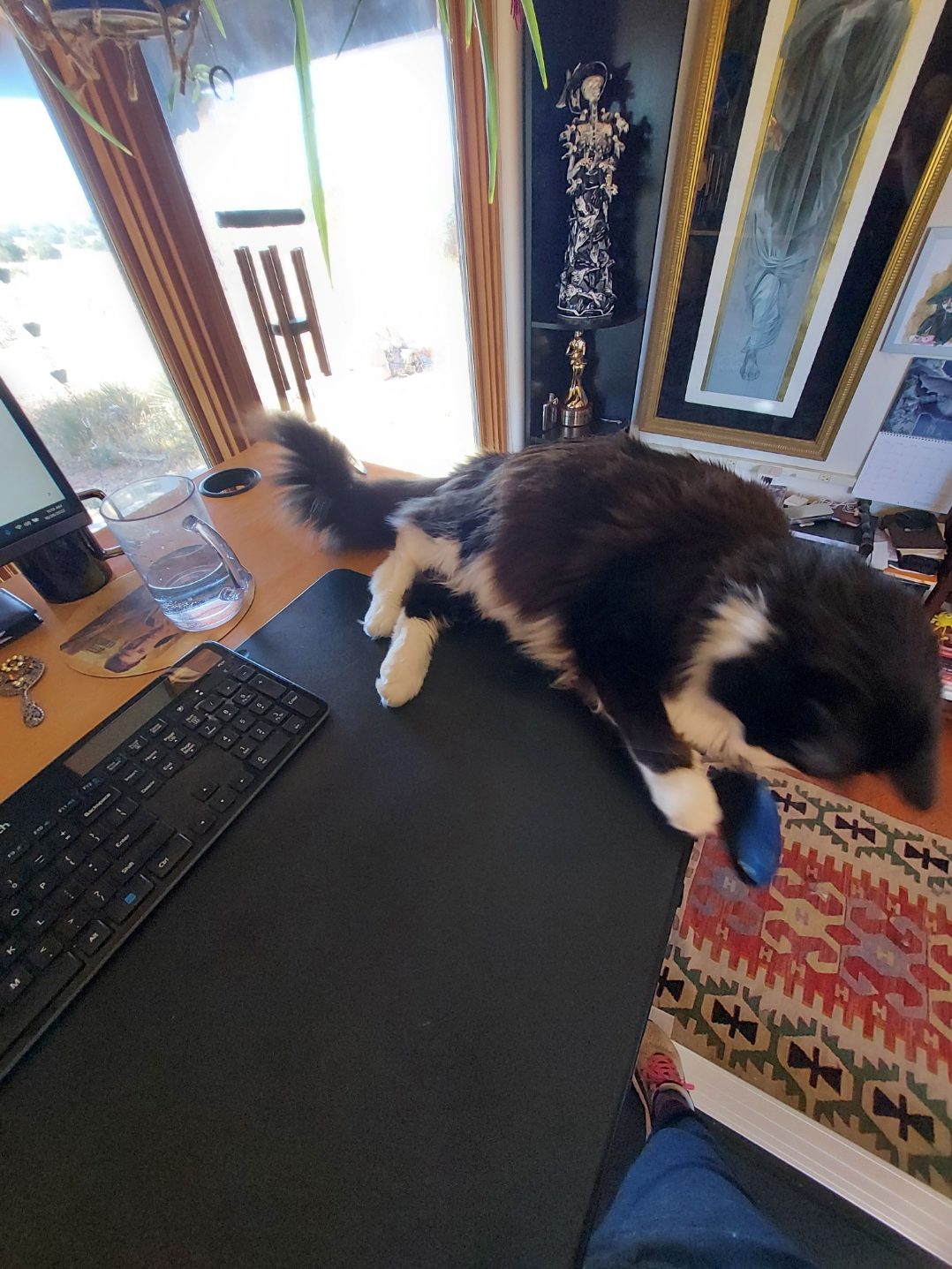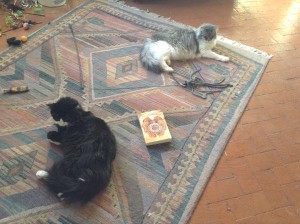On being a creative in a tech-driven culture and how tech has shaped how we deliver our art. Also, embracing our emotions as valid and valuable, needing certain conditions to work, and how all of this affects choosing titles.

RITA ® Award-Winning Author of Fantasy Romance

On being a creative in a tech-driven culture and how tech has shaped how we deliver our art. Also, embracing our emotions as valid and valuable, needing certain conditions to work, and how all of this affects choosing titles.



Our topic at the SFF Seven this week is writing emotion and whether you as the author have to feel the exact emotion you’re writing.
There’s this tale about acting that’s been making the rounds for ages – it’s possibly apocryphal – about Dustin Hoffman being a method actor. That method asks actors to find the emotions within themselves to play the character, to find essentially their alternate self who would be that person and feel that way. The story goes that Hoffman spent an hour getting into that character’s skin and Sir Laurence Olivier strolled in, did his bit, and left again, saying, “My dear boy, it’s called acting.”
The point of this (again, possibly apocryphal) tale is twofold: the first that you can create the appearance of emotion without feeling it, and the second that everyone does things their own way.
You all should know by now that my primary mantra is this: figure out what your process is and own it.
People like that story because they can smirk at poor Dustin Hoffman doing things the American way, the overly-complicated way, the fancy way, but… is he wrong? Hoffman has an amazing acting career. He’s widely acknowledged as a brilliant actor. Clearly his approach isn’t “wrong.”
Is Olivier wrong in this story? Clearly not, for the same reasons as above. There is no wrong. There is no right. Both things can be true. Both processes work for those performers.
So, do I have to feel the emotion I’m writing in order to put it on the page? Nope. Do I sometimes? Sure, though it depends. Do other writers need to feel the emotion to write it? I’ve heard they do.
And it’s all good. Both things can be true.

Why I don’t believe in muses and how conflating the experience of writing – joyful or otherwise – with the experience of reading is counterproductive, and how writing turns out the same whether it was fun to write or not.

 I’m over at Word-Whores today, talking about the writer’s nasty secret – that we’re mining your emotional issues to build our characters.
I’m over at Word-Whores today, talking about the writer’s nasty secret – that we’re mining your emotional issues to build our characters.
 I’m over at Word Whores, giving my tricks for putting more emotion on the page – something that was not intuitively easy for me.
I’m over at Word Whores, giving my tricks for putting more emotion on the page – something that was not intuitively easy for me.

Welcome to Day Two of our adventure in exploring calorie-free ways to evoke the holiday spirit.
Yesterday I talked about the realm of scent. How lotions and body scrubs can evoke that special celebratory feeling. You may have seen my old friend, Kev, asking if this really works. He’s a rare person who has no sense of smell. He thought that for people who can smell, scent only makes you hungrier. This can be true. However, I’ve found that indulging in the scent of something delicious is satisfying in itself. Some of this might tie into breaking those habits of emotional eating, like I’ve described with fasting. Just because something smells desirable doesn’t mean you eat it. But enjoy the lovely scents nonetheless.
So today we add a layer of taste to the mix. How to enjoy flavor without calories (or manufactured chemicals with disconcerting FDA histories)?
Tea: warm, sweet, spicy and good for you
Tea is a wonderful thing. It’s warm. The range of scents and flavors vary all over the spectrum. You can drink all you like without a single calorie and, if you choose carefully, they’re even good for you. The best part is, you can add in some festive glassware for that extra celebratory touch.
Let’s face it – half the fun of Starbucks at holiday time is getting the festive red cup. It’s silly and yet it makes us happy to see them. And those special flavors they have only for the holidays? Oh yes. I saw the ripple across twitter when people announced the pumpkin-spice lattes were out. And now those ginger-spice lattes and black-cherry mochas. It’s clever marketing because having those flavors only at this time of year makes them special. That’s entirely the trick of creating your own celebratory treat.
Sadly, those ginger spice lattes are not sugar-free. And for me, now that I’m staying away from milk and from caffeine – that doesn’t leave much in the cup.
So, I’m indulging in tea. Pick a special mug for Christmas. Something that evokes the season for you. A few years back I gave my mom these great metallic mugs that look like Christmas tree ornaments. I still regret not getting some for myself. But there are lots of pretty mugs and fabulous tea pots. I like to brew my tea in a ceramic pot that I keep on my desk for easy refilling.
While shopping with my mom and Hope, I discovered Teavana. Fair warning: Teavana is quite “too.” The tea is expensive and it comes with specific instructions on what temperature to steep it at and for exactly how long. This is so not me. I boil the water. I throw the tea in an infuser, throw it all in the tea pot and it sits on my desk that way all morning. No doubt the lovely and precise sales lady who explained the instructions to me would be wringing her perfectly manicured hands in anguish.
I’m just saying – don’t let that stop you.
They got me on this blend of White Ayurvedic Chai and Samurai Chai Mate. The latter does have caffeine, but I can control the amount by how much I add to the infuser. Ah, the scent, the warm sweet taste. It’s like being in a tea house in Europe with an antique book while snow falls outside.
Or at least, how I imagine that would be.
There’s lots of easy tea choices. The site that provided the picture above seems to have good information. And Damn Fine Tea, which is run by some friends of mine, has a special holiday blend this year. (No, they didn’t give me tea to say this, but they should!) It’s also as simple, though, as plucking a box of tea off the grocery store shelf. Peppermint, cinnamon, cloves. Pick the spice that makes you feel special. Cozy up to your festive mug and sip. Let the brew transport you.
There’s a reason writers love tea.
 David and I have started fasting once a week, just for 24 hours.
David and I have started fasting once a week, just for 24 hours.
No – it’s not a religious thing, which is the first question another friend asked me in horror. It’s a health thing.
It’s interesting: we have this built-in cultural fear of going without food. The first question most people ask is if that’s healthy. Between our ancestral, and very real fear, of starving and our modern cultural icons of body-image psychosis that leads to anorexia, the idea of not eating is frightening to us.
But yes, it is healthy. A 24-hour fast once a week cleanses the digestive system and stimulates the immune system. It’s a good practice for warding off chronic disease, especially now that we’re middle-aged. We simply stop eating after dinner on Sunday night, then drink only water until Monday evening, when we break fast with a salad of red cabbage, beets and carrots.
Yeah, it was hard the first few weeks. My blood sugar dropped. I was headachey and dizzy, having a hard time concentrating. After that, my body got a lot better at unlocking the sugar I needed from my fat stores, which is what I want it to get good at doing. My body got a lot better at keeping an even balance, rather than demanding caffeine and sugar to keep going.
The best part is how good I feel the next day. The process leaves me feeling vital and energized.
The most interesting part though, is the food fantasies.
I’ll be working away and suddenly a daydream will seize me. I’ll want a cupcake, more than anything in the world. Or my mouth will suddenly flood with the taste of a baked potato oozing with butter. I’ll think I want food I never eat, or haven’t eaten in years. Sometimes, my brain will try to trick me, but inserting a random thought that I should just pop into the kitchen and grab a cookie. It’s not even being hungry so much as having little temper-tantrums of wanting.
For the first time in my life, I really understand now what emotional-eating is about.
It’s become almost a cliche now. “I ate my emotions” Reese Witherspoon says in defense of her teenage fat in Four Christmases – and it’s a funny line. (Yeah, I know I’m the only person who liked that movie. I laughed and laughed.) But it’s a truism, that much of our eating choices are driven by emotion, not nutrition. We eat to soothe ourselves, to ease the pain of whatever hurts us, to add to the happy.
I’m not saying that’s wrong either. I’m the first one to enjoy that chilled glass of wine. I’ll absolutely gorge on brownies with you to salve the pain of a rejection. Is spaghetti with meatballs one of my favorite comfort foods? Oh yes, yes, yes.
But I think it’s useful to know that. It’s good for me to know that I’m eating my big plate of pasta because it makes me happy, not because my body needs that kind of nutrition.
The other thing fasting does is break the habit of nibbling.
Once I overrule that little pop-up window in my brain that suggest grabbing a cookie, some nuts, a handful of chips, after a while that subroutine stops running. Eating becomes a deliberate choice rather than a habit. Since I work from home, with easy access to a kitchen full of enticing food, I’m pleased to break that particular habit.
Now if I could get people on Twitter to stop sending pictures of their treats…
I once asked my martial arts teacher a question about emotions. This isn’t as odd as it sounds, because it was a kung-fu school and we spent a lot of time talking about chi (life energy) and how emotional energy is the battery for everything we do.
So, I told him how, when I’d lived alone in grad school, I’d sometimes go a whole day or two without seeing anyone. Especially if I was holed up in my apartment on the weekends. This was before all the connectedness of email and Facebook. The world reached me only via my landline, the tv (which I never turned on) and the radio (and I only listened to music). What I’d found was that I wouldn’t notice I was in any particular emotional state, unless I happened to make contact with another person. Then I would discover I was irritable or depressed or happy, by the way I interacted with them.
His answer was that I “downloaded” the other person’s emotions. That I absorbed what they were feeling and that I had to learn to differentiate my emotions from theirs. This led into one of his typical rants about how this was yet another reason for us to shun the world at large and stay away from the contamination of the mass mind.
Obviously, I don’t completely agree. About so many things. Which is neither here nor there.
I think there is something to this, sure. I do think you can pick up on what other people are feeling. If the energetic thing is too woo-woo for you, then suffice to say that we’re really good at picking up subconscious cues from each other. Our pets perceive our feelings and intentions. David knows what state of mind I’m in from the moment I walk in the door. If you’re a reasonably empathetic person who pays attention, you’ll pick up on what the people around you are feeling.
But I don’t think that’s what I experienced in my living-alone days. I think it has something more to do with context. That it’s hard to define something without a point of reference. For example, our visual system works through edge-detection. The receptors in our eyes and the neurons that connect with them respond to the contrast between one color and the next, or one shade and the next. Our visual cortex assembles images from all the lines and edges, then fills in the middle.
Maybe emotional states are like this, too. I might drift through a day or a weekend in an undefined dream. (Okay, yeah, this may be particular to me, being kind of a dreamy gal.) When I encounter someone else, I’m no longer just a wash of being — now there’s someone else and there’s a line between us, created by our differences, slight or great. Suddenly I have a point of reference.
The rest is just filling in the middle.